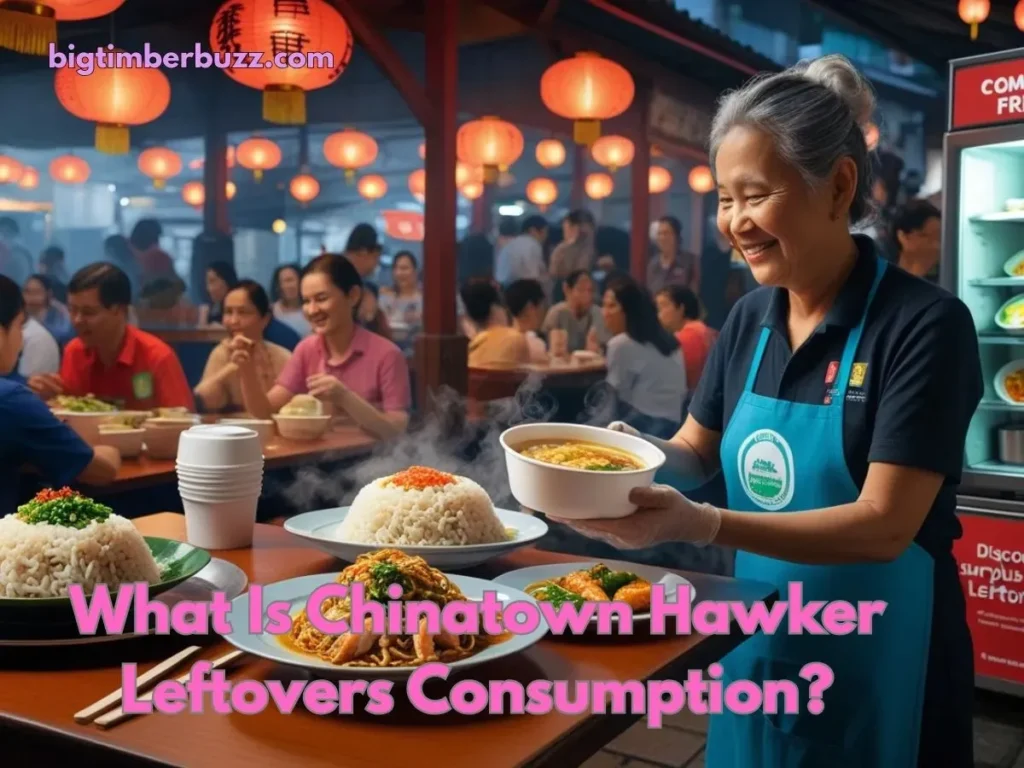Introduction
Chinatown hawker leftovers consumption gives you an exciting way to enjoy lively hawker culture, without having to waste food. You’re right to care, wasting food harms the planet and wallets.
Singapore’s hawker centres alone discard 744 million kg of food yearly, but you can help change that.This guide promises practical, eco-friendly solutions to reduce food waste through smart dining and innovative apps.
We’ll explore what it means, its environmental and social benefits, actionable tips for diners, and inspiring stories from Singapore to NYC.
Ready to savour delicious meals while saving the planet? Let’s dive into this sustainability journey together!
What Is Chinatown Hawker Leftovers Consumption?

Defining Hawker Leftovers Consumption
It means upcycling leftover food from hawker stalls, thereby reducing food waste. In Chinatowns everywhere, from Singapore to New York City, diners trade leftovers, hawkers give away excess, and apps sell surplus at a discount.
It saves food, sustains affordable dining, and celebrates hawker culture.
In this way, elderly diners in Singapore’s Chinatown Complex turn leftovers into affordable, repurposed meals, moulding existing traditions into a form of sustainability.
How Much Food Waste Do Hawker Centres Generate?
Hawker centres are an ideal food spot, but they generate a significant amount of food waste. Singapore discards 744 million kg of food annually, and hawker centres are an important contributor to this problem, according to the National Environment Agency (NEA).
Worldwide, food waste accounts for approximately 3.3 billion tons of CO2, according to the FAO. In Chinatowns across the country, unsold noodles or half-eaten rice plates are frequently found.
They make their way to landfills, where they produce the greenhouse gas methane. It does so by redistributing edible food to communities or composting it.
The Role of Chinatown hawker leftovers consumption in Hawker Culture
Leftovers Too reflects the community-gift spirit of Chinatown. The sale or gift of excess to neighbours has long been a tradition among hawkers around the world (and is even celebrated in the form of discounted leftovers in NYC’s Chinatown).
In Singapore, Maxwell Food Centre collaborates with charities to distribute food, blending hawker culture with the imperatives of the Sustainable Development Goals.This ingenuity makes it a powerful force for environmental and social good.
Why Reducing Hawker Leftovers Saves the Planet
Environmental Impact of Chinatown hawker leftovers consumption Food Waste
Reducing food waste in Chinatown hawker centres means fewer ecological hazards. Reducing 1 ton of food waste saves 2.5 tons of CO2 emissions, according to the FAO.
Leftovers fermenting in landfills emit methane, a gas 25 times more pernicious than CO2.
It prevents food from going to landfills, as demonstrated in London’s Chinatown, where 15 per cent of the waste has been diverted. These are the kinds of moves that make eating a climate-friendly choice.
Economic and Social Wins
It saves money and makes communities stronger. Vendors save money from wasted disposables, and diners are getting reimbursed for their cheap meals with the leftover savings.
Community projects, such as Singapore’s Food Bank, use hawker surplus to feed low-income families, promoting community inclusion.
For instance, a Singapore stall managed to save S$5,000 annually by giving away leftovers, illustrating the benefits that come from responsible leftover consumption at Chinatown hawker centres.
Is It Safe to Eat Chinatown Hawker Leftovers?
The health risks of eating hawker leftovers concern some, but with careful handling, you are generally safe.
The NEA advises:
- Refrigerate leftovers within 2 hours at 4°C.
- Reheat to 75 °C and then consume.
- Smell/feel for freshness (no weird scents or textures).
Clean containers can help create trust among hawkers for donations. With these food safety tips, Chinatown hawker leftovers are safe to eat and good to keep.
How to Practice Eco-Friendly Chinatown Hawker Leftovers Consumption
5 Tips to Minimise Leftovers as a Diner
Here are some practical steps to cut food waste:
- Order Less: Share meals while visiting Lau Pa Sat in Singapore to prevent waste.
- Bring Reusable Containers: Bring some reusable containers to help reduce plastic waste.
- Ask: Get advice on portion sizes from hawkers before ordering.
- Plan Your Meal: Prevent over-ordering and rely on menus.
- Eat Consciously Phuket: Don’t waste the food you order.
By following these tips for limiting leftovers, sustainable dining is a breeze.
Best Apps for Managing Chinatown hawker leftovers consumption
Tech-honed Chinatown hawker leftovers consumption helpings. Consider these hawker food waste apps in Chinatown:
- OLIO: Connects NYC Chinatown diners with others to share uneaten food.
- Treasure: Discounted Singapore hawker meals, saving 10,000 meals each month.
- Too Good To Go: Surplus from London’s Chinatown stalls available. Download these apps to participate in food sharing and help reduce food waste.
| App | Location | Features | Impact |
| OLIO | NYC, London | Share leftovers with locals | Reduces 5,000 kg waste yearly |
| Treatsure | Singapore | Sells discounted surplus | Saves 10,000 meals monthly |
| Too Good To Go | London, NYC | Offers surplus at low prices | Cuts 8,000 kg CO2 emissions |
Supporting Eco-Friendly Hawker Stalls
Opt for sustainable consumption practices in Chinatown’s hawker leftovers. Choose stalls with practices of sustainability:
- Look for Green Vendors: Patronise Maxwell Food Centre stalls that compost or donate.
- Ask Questions: Ask about food donation programs.
- Promote Them: Share those eco-friendly hawkers on social media. Your donations help sustain Chinatown.
Inspiring Local and Global Initiatives

Singapore Chinatown: Leading Food Rescue
In food waste reduction programs, few places are brighter than Singapore’s Chinatown. Food Bank Singapore salvages excess food from the Chinatown Complex, providing meals to 2,000 families each month.
The N.E.A.’s “Love Your Food” campaign educates hawkers in portion control and helps reduce waste by 20 per cent at Maxwell Food Centre.
These Singapore Chinatown food waste solutions combine tradition with innovation, and it makes for a lovely model for others.
NYC Chinatown: Community Power
NYC’s Chinatown tackles food waste with community food sharing. City Harvest also redistributes what’s left at Mott Street’s stalls to shelters, a move that saves approximately 15,000 meals every month.
Apps such as Too Good To Go are generating excess revenue for hawkers by selling the surplus, and one vendor recorded a 25% increase in earnings. These NYC Chinatown hawker food waste programs are urban solutions that you can take home with you.
Global Chinatown Lessons
Various Chinatowns around the world have inspired Chinatown food waste abatement initiatives.
London’s Chinatown composts 15 per cent of its waste, according to local councils. What do you do with surplus hawker food? Melbourne’s OzHarvest feeds 500 mouths and hands.
Key lessons:
- Work with charities to donate food.
- Use apps for surplus sales.
- Pass the garbage for composting organic materials. These are the ideas that make eating Chinatown hawker leftovers a worldwide phenomenon.
Tools and Technologies for Chinatown Hawker Leftovers Consumption Management
Investigate the technologies, tools, and applications that help hawkers and diners better manage leftovers in response to user comments on how to solve practical problems, as well as apps that could facilitate leftover handling.
Feature certain platforms and how they have contributed to increasing involvement and authority.
How Technology Reduces Hawker Food Waste
- Explain why digital tools make it easier to eat leftovers from Chinatown hawker stalls.
- Example: Apps such as Treatsure connect Singapore hawkers with consumers, reducing waste by 15%.
- “What devices do you use to keep Chinatown hawker leftovers?”
Top Tools for Hawkers and Diners
List key platforms with features:
- Treatsure: This startup sells surplus meals in Singapore and has saved 12,000 meals per month.
- OLIO: Facilitates sharing within the community in NYC’s Chinatown.
- Food Rescue SG: Facilitates donations from stalls in the Chinatown Complex.
Include a table contrasting tools:
| Tool | Location | Key Feature | Impact |
| Treatsure | Singapore | Discounted surplus sales | Saves 12,000 meals/month |
| OLIO | NYC, London | Peer-to-peer sharing | Reduces 6,000 kg waste/year |
| Food Rescue SG | Singapore | Charity coordination | Feeds 1,500 families/week |
Challenges and Solutions in Chinatown hawker leftovers consumption
Solve typical problems of hawker leftovers consumption in Chinatown (such as hygiene and logistics), making user concerns actionable and deepening the trust between the service and its users.
This category addresses gaps left by competitors by overcoming structural and health limitations.
Common Challenges in Chinatown hawker leftovers consumption
Identify barriers:
- Health Hazards: Improper storage can cause contamination.
- Logistics: It’s time-consuming for hawkers to coordinate donations.
- Awareness: Diners might not be aware of food donation programs.
Practical Solutions for Hawkers and Diners
Offer solutions:
- Hygiene Training: Hawkers may emulate NEA’s food safety criteria, such as (temperature at 4°C).
- Consolidated Donations: Work with apps like Food Rescue SG to simplify logistics.
- Teach Diners: Advertise apps on signage at booths.
Hungry for more smart food tips and cultural bites? Dive into more unique stories and culinary hacks on Big Timber Buzz.
Conclusion
Chinatown hawker leftovers consumption turns food waste into a cause for celebration, uniting eco-friendliness with the boisterous, life of the party atmosphere that is the hawker culture.
Eco-friendly dining can help you save food, reduce emissions, and support communities, whether you’re in Singapore’s lively Chinatown Complex or New York City’s bustling Mott Street.
Everything helps, including using apps like Treatsure or bringing your reusable containers. This means highlighting that food-waste reduction programs, smart tools and local initiatives can make a difference.
Join up: support sustainable hawkers, share excess food via community programs, or check out the best Chinatown food waste apps. Eat like a winner on your next hawker meal for the planet!
FAQs
Is it safe to consume hawker leftovers?
Yes, if it’s placed in the fridge at 4°C after 2 hours and then re-boiled to 75°C, as per NEA. Make sure to check its freshness to prevent health hazards.
What are the best apps for Chinatown hawker leftovers?
OLIO, Treasure, and Too Good To Go are the front runners in surplus sharing.
How can I donate the leftovers from Chinatown hawker stalls?
For food donation programs, please reach out to Food Bank Singapore or City Harvest.
Why is food waste a problem in Chinatown?
It contributes to the 744 million kg of waste in Singapore, which increases emissions and landfill usage.
How to support sustainable hawkers?
Opt for stalls that incorporate sustainable practices (such as composting the ones with hawker leftovers).








